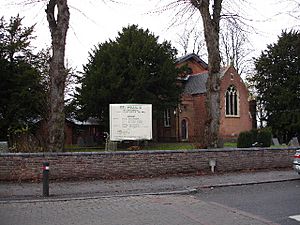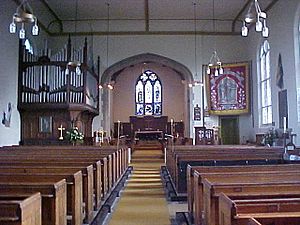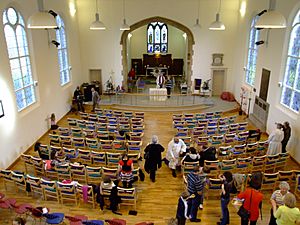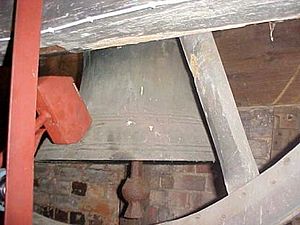St Paul's Church, Stockingford facts for kids
Quick facts for kids St Paul's, Stockingford |
|
|---|---|

St Paul's Church, seen from Church Road
|
|
| 52°31′10″N 1°30′33″W / 52.519404°N 1.509245°W | |
| OS grid reference | SP 33349 91403 |
| Country | England |
| Denomination | Church of England |
| Website | www.stpaulsstockingford.org.uk |
| History | |
| Dedication | St Paul |
| Administration | |
| Parish | Stockingford |
| Diocese | Coventry |
| Province | Canterbury |
St Paul's Church in Stockingford is a special church in Nuneaton, England. It's part of the Church of England. This church has a long and interesting history.
Contents
Where is St Paul's Church?
You can find St Paul's Church on Church Road in Stockingford. It's close to where Church Road meets St Paul's Road. The church has a large churchyard around it, which is about 5,260 square meters big.
The Church's Story
Around 1819, there were protests in Stockingford. People who made hosiery at home were told their pay would be cut. They protested in the streets. The local church, St Nicholas in Nuneaton, decided to build a new church. This new church, called a "chapel of ease," would help calm things down. Work on St Paul's Church began in 1822. It was officially opened in 1824.
The Church Building
St Paul's Church is a very important building. It is listed as a Grade II building in the National Heritage List for England. This means it's protected because of its special history and design. The first part of the church was built in 1822. It was designed by John Russell from Leamington Spa. The church has been changed and added to many times since then.
The Original Church from 1822
The first stone for the church was laid in 1822. The oldest parts are the main hall, called the nave, and the tower. These parts were built in a neo-classical style. This style uses ideas from ancient Greek and Roman buildings. The roofs are made of slate and lead. The walls are dark red bricks. The windows have large diamond patterns with colored glass.
The nave has a flat ceiling. It used to have a wooden floor. The original church also had a small, round area at the front called an apse. When it first opened, the church had 520 free seats and 88 other seats. Building the church cost about £2,000. The church was officially opened on April 22, 1824. Bishop Henry Ryder led the ceremony.
The Chancel Added in 1897
A new part, called the chancel, was added in 1897. It was designed by G.B. Vialls in a Gothic revival style. This style looks like old medieval churches. This addition cost £1,200. After this, the church had a chancel, a nave, and a tower at the back. There are also small rooms, called vestries, on both sides of the chancel.
The chancel has an open wooden ceiling. The floor is made of stone slabs. There are also some wooden blocks around the choir stalls. You can see a beautiful mosaic on the altar platform. This mosaic is made from special glass tiles. It was covered by carpet for many years. People forgot about it until it was found again in 2008. At the same time, the church was rearranged. The old seats in the nave were replaced with wooden pews.
The 1995 Extension
In 1995, St Paul's Church got bigger. A new part called the Parish Centre was added. This extension was built on the south side of the church. The money for it was raised by the people of Stockingford. They also got a grant from the European Union. A new entrance, called a south porch, was built to connect the church to the new centre. Some pews were moved to make space for this new entrance. You can see this in the picture.
The new centre was officially opened on January 15, 1995. The Bishop of Coventry, Simon Barrington-Ward, dedicated it. The youngest and oldest members of the church, Thom Udall and Fred Ward, opened it.
Changes in 2008
More changes were made to the church building starting in September 2008. The old pews were taken out. The inside of the church was redesigned. A new Church Hall was created for local community groups to use.
The old pipe organ, which was put in in 1909, was carefully taken apart. It was then moved to Dijon, France. There, it was rebuilt in a Catholic church. A new digital organ was put in St Paul's instead. The old floor was removed and a new one was put in. The new floor has oak boards and underfloor heating. This means the church can be warm and cozy. There were also some problems with the ground in the chancel area. These were fixed by strengthening the foundations.
A group called WREN gave a grant of £50,000. This money helped pay for the parts of the new building that the community would use. All the work took about ten weeks. During this time, the beautiful glass mosaic from 1897 was found under a carpet. It was cleaned and left in its place.
Other Renovations and Changes
St Paul's Church has had many smaller updates over the years:
- 1867: A new clock was put in.
- 1870: A heating system using coal and hot water pipes was installed.
- 1871: New windows were put in the nave.
- 1900: The churchyard was made bigger.
- 1904: Gas lighting was added.
- 1909: A new pipe organ was installed.
- 1921: Electric lights were fitted.
- 1939: Repairs were made to the chancel and choir vestry.
- 1962: The heating system was changed from coal to oil.
- 1994: The East Wall was strengthened to stop it from moving.
- 1999: Another new clock was installed.
- 2008: The inside of the church was redesigned.
Church Leaders
The current vicar at St Paul's is the Rev Kate Massey. Many vicars have served at St Paul's Church since it opened. Here are some of them:
- 1824: Revd. T. J. Crackett
- 1828: Revd. J. E. Jones
- 1831: Revd. T. R. Docker
- 1832: Revd. S. Backler
- 1839: Revd. H. Hake
- 1839: Revd. J. Price
- 1845: Revd. J. Bickerdike
- 1852: Revd. J. Coling
- 1857: Revd. J. Thomas
- 1864: Revd. C. E. Baskerville
- 1864: Revd. G. R. Pennington
- 1871: Revd. A. S. Webb
- 1884: Revd. W. C. Macdona
- 1885: Revd. J. B. Pattison
- 1895: Revd. G. E. Warlow
- 1903: Revd. J. H. Ashe
- 1920: Revd. J. M. Philpott
- 1927: Revd. J. Pratt
- 1951: Revd. E. Taylor
- 1958: Revd. P. G. Croft
- 1965: Revd. A. R. Hooton
- 1990: Revd. M. F. Vincent
- 2015: Revd. K. Massey
The Church Clock
When the church tower was built in 1822–1823, it had a clock and a bell. In 1867, a new clock was put in by H Bright of Leamington Spa. Sadly, this clock stopped working in the 1970s and was not fixed for a long time.
In the 1990s, the bell was thought to be unsafe. It was fixed in place, and its rope was removed. In 1999, clockmakers Smith of Derby Group repaired the clock and bell. For the first time in 30 years, the clock chimed at midnight on January 1, 2000. This marked the start of the new millennium.
Now, the bell is held firmly in a frame. The new clock mechanism uses a hammer to strike the bell. The new clock has three faces. The north and south faces are run by the clock's gears. The west face is run electronically.
Special Memorials
St Paul's Church has memorials to remember people from the area who died in wars.
Remembering the First World War
In 1922, a beautiful stained glass window was put in. It cost £500. This window is a memorial to the 201 people from the area who died in the First World War. Mr R Anning Bell designed and installed it. To complete the memorial, wooden panels were put under the window. A brass tablet lists the names of the soldiers who died.
The churchyard also has a war grave. It belongs to a soldier from the Royal Garrison Artillery who died in 1918.
Remembering the Second World War
In 1946, a plaque was put up to remember 17 men from the church's area. They died in the Second World War. This plaque is placed under the First World War memorial.
The 1st Battalion Cambridge Regiment was based nearby in 1941. These soldiers worshipped at St Paul's. Sadly, 343 of them died between 1942 and 1945 while fighting far away. A plaque remembering these men was placed next to the war memorial.
Connection to George Eliot
The famous writer George Eliot wrote about Stockingford in her book "Scenes of Clerical Life." She called Stockingford "Paddiford Common." St Paul's Church is mentioned in her book as the "chapel of ease." One of her characters, Revd. Tryan, is based on Revd. John Edmund Jones. He was the vicar at St Paul's from 1828 to 1831. Another character, Mr Landor, is based on Mr Craddock. He laid the first stone of the church in 1822.
See Also




